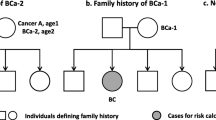Abstract
A study was conducted to investigate the clinical and pathological characteristics of breast cancer in patients with a family history (FH). Among 4,481 primary breast cancer patients, 394 (8.8%) had families which included two or more breast cancer patients within three generations (FH(+) group). This group was compared with the remaining 3,969 patients (FH(−) group) with the following results: (1) The tumor diameter in the FH(+) group was slightly less than that in the FH(−) group [not significant (NS)], with fewer lymph node metastases (P<0.05); (2) the positive rates for the estrogen receptor were 52% (138/266) and 49% (1,216/2,481), respectively (NS); (3) expression of the c-erbB-2 protein was observed in 14 out of 40 (35%) and 32 out of 100 cases (32%), respectively (NS); (4) the relative risk of bilateral occurrence in the FH(+) group was 1.4, with a 95% confidence interval of 0.9–2.4; (5) the 15-year survival rate was 72% and 60%, respectively, suggesting a better prognosis for the FH(+) group (P<0.01); and (6) multivariate analysis showed that the contribution of FH to postoperative survival was marginal (P=0.07). Factors related to the hormonal environment such as age at menarche (P=0.08) and age at menopause (P=0.08) made a greater but non-significant contribution to the prognosis of the FH(+) group than to that of the FH(−) group. However, further genetic and molecular biological analyses of familial breast cancer are needed in order to clarify the mechanisms of cancer accumulation within families.
Similar content being viewed by others
References
Noguchi S, Miyauchi K, Nishizawa Y, Koyama H (1988) Comparison of enzyme immunoassay and tritiated steroid binding assay for estrogen and progesterone receptor assay in 56 breast cancer cytosols (in Japanese). Nihon Gan Chiryou Gakkai Zasshi (J Jpn Soc Cancer Ther) 23:1257–1264
Tsuda H, Hirohashi S, Shimosato Y, Tanaka Y, Hirota T, Tsugane S, Shiraishi M, Toyoshima K, Yamamoto T, Terada M, Sugimura T (1990) Immunohistochemical study on overexpression of c-erbB-2 protein in human breast cancer: Its correlation with gene amplification and long-term survival of patients. Jpn J Cancer Res 81:327–332
Peto R, Peto J (1972) Asymptotically efficient rank invariant test procedures. J R Stat Soc A 135:185–206
Cox DR (1972) Regression models and life tables. J R Stat Soc B 34:187–220
Tominaga S, Yoshida Y, Takatani O, Ishida T, Nanasawa T, Sakamoto G, Hirayama Y, Hirohata T, Murata K, Watanabe S, Kuroishi T, Kato I (1988) High risk group of breast cancer (in Japanese). Nyuugan no Rinsho (Jpn J Breast Cancer) 3:251–271
Lynch HT, Marcus JN, Watson P (1989) Familial and genetic factors — new evidence. In: Stoll B (ed) A woman at high risk to breast cancer. Kluwer, Dordrecht, p 27
Nomizu T, Tsuchiya A, Abe R (1987) Clinical study of breast cancer patients with family history (in Japanese). Nyuugan no Rinsho (Jpn J Breast Cancer) 2:435–439
Bain C, Speizer B, Rosner B, Belanger C, Hennekens CH (1980) Family history of breast cancer as a risk indication for the disease. Am J Epidemiol 111:301–308
Sattin RW, Rubin GL, Webster LA, Huezo CM, Wingo PA, Ory HW, Layde PM (1985) Family history and the risk of breast cancer. JAMA 253:1908–1913
Ogawa H, Kato I, Tominaga S (1985) Family history of cancer among cancer patients. Jpn J Cancer Res 76:113–118
Newman B, Austin MA, Lee M, King MC (1988) Inheritance of human breast cancer: Evidence for autosomal dominant transmission in high-risk families. Proc Natl Acad Sci USA 85:3044–3048
Tryggvadottir L, Tulinius H, Robertson JM (1988) Familial and sporadic breast cancer cases in Iceland: A comparison related to ABO blood groups and risk of breast cancer. Int J Cancer 42:499–501
Lynch HT, Watson P, Conway T, Fitzsimmons ML, Lynch J (1988) Breast cancer family history as a risk factor for early onset breast cancer. Breast Cancer Res Treat 11:263–267
Anderson DE, Badzioch MD (1986) Survival in familial breast cancer patients. Cancer 58:360–365
Murata M, Kuno K, Fukami A, Sakamoto G (1982) Epidemiology of familial predisposition for breast cancer in Japan. J Natl Cancer Inst 69:1229–1234
Lemon HM (1969) Endocrine influences on human mammary cancer formation: A critique. Cancer 23:781–790
Anderson DE, Badzioch MD (1985) Bilaterality in familial breast cancer patients. Cancer 56:2092–2098
Malkin D, Li FP, Strong LC, Fraumeni JF, Nelson CE, Kim DH, Kassei J, Gryka MA, Bischoff FZ, Tainsky MA, Friend SH (1990) Germ line p53 mutations in a familial syndrome of breast cancer, sarcomas, and other neoplasms. Science 250:1233–1238
Hall JM, Lee MK, Newman B, Morrow JE, Anderson LA, Huey B, King MC (1990) Linkage of early-onset familial breast cancer to chromosome 17q21. Science 250:1684–1689
Author information
Authors and Affiliations
Rights and permissions
About this article
Cite this article
Fukutomi, T., Kobayashi, Y., Nanasawa, T. et al. A clinicopathological analysis of breast cancer in patients with a family history. Surg Today 23, 849–854 (1993). https://doi.org/10.1007/BF00311360
Received:
Accepted:
Issue Date:
DOI: https://doi.org/10.1007/BF00311360




